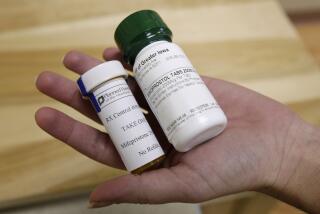Baby Boomers Fuel Surge in Drug Spending
- Share via
The growing demand for prescription drugs, especially among baby boomers determined to remain healthy and active, is driving the rise in prescription spending as much as the industry’s price increases, according to data released this week.
And health-care experts say that trend probably won’t abate, suggesting that prescription drug spending will continue to push up overall health-care costs.
The drug industry counters that using more and better drugs reduces other health-care costs, offsetting the rise in spending on prescriptions.
In a report released Friday, the National Institute for Health Care Management said prescription drug spending rose 17.1% in 2001, the fourth consecutive year of increases of at least 17%.
The study said about one-third of the increase was linked to price hikes, with the rest attributed to more prescriptions being written or to patients switching to more- expensive drugs.
Seven of the top 10 drug types--in terms of 2001 retail sales--are used extensively by older Americans, said the institute’s research director, Steven Findlay.
“Clearly a part of the rise is due to that generation merging into its middle-aged years. Most people suffering from depression are older. Those most vulnerable to the side effects of older anti-ulcer drugs [and thereby likely to switch to newer, more-expensive ones] are also older. Cholesterol-fighting drugs are definitely age-related,” Findlay said, citing the three biggest drug classes in 2001 sales.
Other major categories of drugs used heavily by older consumers are anti-arthritis, anti-hypertension, narcotic painkillers and oral diabetes medications.
Findlay said the shifting demographics probably were a factor in the sharp rise in the number of prescriptions written, which climbed from 1.9 billion 10 years ago to 3.1billion in 2001.
“Quite a few of these are for chronic conditions affecting older Americans,” Findlay said.
The drug industry responded to the study by saying that medications play a huge role in creating healthier Americans who require less care.
“Instead of ‘Another Year of Escalating Costs,’ NIHCM should have called the study ‘Another Year of Improving Health Care,’” said Alan F. Holmer, president of the Washington-based Pharmaceutical Manufacturers Assn., an industry trade group.
“The study reflects the fact that more people are now being treated for diseases such as diabetes, asthma, depression and elevated cholesterol,” Holmer said. “New medicines for these diseases can save lives and get people back to work faster.”
That sentiment was echoed by Frank Lichtenberg, a Columbia University professor of finance and economics whose research on the efficacy of new patented drugs has been funded in part by the pharmaceutical industry.
Using a government database of more than 20,000 Americans, Lichtenberg said he found clear evidence through 1998 that medications recently approved by the Food and Drug Administration were not only more effective than older drugs but resulted in healthier outcomes and fewer acute-care emergencies.
That more than compensated for the higher cost of the drugs, Lichtenberg said.
But several experts disagreed, saying the latest and most expensive drugs haven’t been around long enough to determine their clinical effect.
With the large baby boom group in middle age, the number of acute health episodes, such as heart attacks and cancer, probably won’t diminish, they say.
“Some drugs definitely offset or reduce other health-care costs,” said Eric P. Michael, a Minneapolis-based pharmaceutical expert for William M. Mercer Co.
He cited the leukemia drug Gleevec, which has helped many patients avoid the need for painful bone marrow transplants.
“But others clearly don’t offset,” Michael said. “There is no clear-cut medical benefit that warrants the increase in price, and the average consumer won’t know which is which.”







